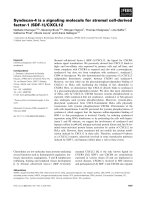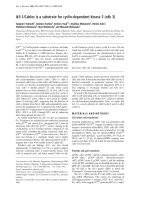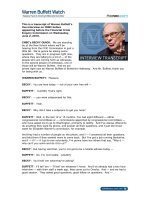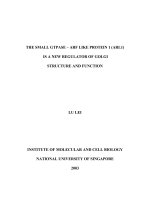Jet primary teachers resource books 1
Bạn đang xem bản rút gọn của tài liệu. Xem và tải ngay bản đầy đủ của tài liệu tại đây (5.29 MB, 91 trang )
J
PRIMARY
TEACHERS'
LiaJ i -J
_J.J
c
•
Welcome to
the / e t Primary
Teachers' Resource
Book 1
Aims
Our main aim is to provide primary school
teachers with easy-to-prepare materials
which can be used as one-off revision
activities or as part of a fuller theme-based
project. As all primary EFL teachers know,
children need to have new language
constantly recycled and these Photocopiable
Pages provide a fresh way of doing just that.
In addition, the preparation of these
materials (most of which can be done by the
pupils themselves) allows for free and
spontaneous language practice.
The Book
This book includes 46 Photocopiable Pages
accompanied by Teacher's Notes on facing
pages. Where an idea requires two
Photocopiable Pages to be used together,
the Notes face the first of the two
Photocopiable Pages. The ideas contained
here have been tried and tested by Primary
teachers through jet magazine and have
been selected to include a variety of
acivities, such as games, art and craft,
worksheets and songs.
Themes
The Photocopiable Pages in this book are
topic-based. The themes for this first volume
are Christmas, Myself and Animals, chosen
| to include the cultural and seasonal input
I which teachers so often request, while being
mmmmmmmmmm®
relevant and of
interest to children.
The Photocopiable Pages are
referred to by the first 2 letters of the themes
plus page number (e.g. Christmas, page 1 =
CH/01, and Myself, page 1 = MY/01.)
Language Level
We have not specified a target age or language
level for these materials as each activity is
designed as a starting point from which
individual teachers can meet their own
classroom needs. Our Teacher's Notes suggest
one way of using the Photocopiable Pages,
but these can be easily adapted to suit
different age groups and language levels.
Throughout the notes the following symbols
have been used to indicate whether activities
are for individual work (Q), pair work (Q)©,
or groupwork(Q)®(Q)-
Photocopiable Rights
The 46 Photocopiable Pages provided can be
photocopied freely for use in the classroom
and do not need to be declared.
Language
Photocopiable material
Page
numbers, dates,
Christmas vocabulary,
colours, house vocabulary,
there is/there are
Advent calendar to
construct
CH/01
CH/02
Christmas Cards
imperatives (make/colour/
stick/cut out/write), greetings
Cards to cut out and
colour
CH/03
CH/04
Christmas Songs
action verbs (dap, jump,
play, cook, make, eat)
Song lyrics and music
CH/05
colours, numbers
Mobiles to cut out and
colour
CH/06
Santa's Holiday
clothes vocabulary,
he's got, going to future
Board game/drawing
CH/07
CH/08
Presents Tree
adjectives, what's this?
It's a
going to future
Picture puzzle
CH/09
I'd/he'd/she'd
Picture puzzle
CH/10
guided letter writing
Skeleton thank you
letter to complete
CH/11
can/can't,
present continuous tense,
has got, colours
Card game to cut out
CH/12
It's a..., I've got...
Board game
CH/13
CH/14
Giving personal information
name/ad dress/age
Information to complete
MY/01
colours/numbers/dates
Present to colour
MY/02
story-telling with
present simple and
present contlnuouse tense
Story-sequencing
pictures
MY/03
like/don't like, good at/bad at
Card game
MY/04
present simple tense
collecting/presenting
Information
Chart/survey
MY/05
body vocabulary
Board game
MY/06
body vocabulary,
have got, numbers
Song lyrics and music
MY/07
measuring,
comparatives and superlatives
Graph (height)
MY/08
(s)he's got,
(s)he is wearing
Fingerprint pictures
MY/09
Christmas
Advent Calendars
Christmas Cracker
Mobiles
Presents Maze
Thank You Letters
Snowmen Cards
The Tree Game
like...
Myself
This is Me
My Birthday
My Birthday Present
My Hobbies
My Heroes
The Body Game
Body Songs
My Height
My Fingerprints
Language
Photocopiable material
Page
family vocabulary,
comparatives and superlatives,
has got
Family tree
MY/10
numbers, colours
Puzzle to colour
MY/11
My Mother
writing letters/
gerunds
Mother's Day letter
MY/12
My Room
prepositions
what's this?/it's
Plan of a room
MY/13
past tense (ate/drank/had),
questions with did
Food diary
MY/14
present simple/adverbs of
frequency/telling the time
Chart to complete
MY/15
present simple tense,
going to future
Story sequencing
pictures
MY/16
prepositions,
woodland animal vocabulary
Picture puzzle
AN/01
directions, prepositions,
zoo animal vocabulary
Plan of the zoo
AN/02
has got, body vocabulary,
the possessive's
Picture puzzle
AN/03
Animal Songs
animal and food vocabulary
Song lyrics and music
AN/04
Noah's Ark
has got, animal descriptions
plus cut-out animals
Model ark
AN/05
AN/06
farm and baby animal
vocabulary
Card and dice game
AN/07
present tense, story-telling,
writing
Picture sequencing game
AN/08
present simple tense,
story-telling, animal life chains
A picture book to make
AN/09
Animal Foods
present simple with eats
food vocabulary
Card game to cut out
AN/10
AN/06
Animal Habitats
present simple with Hues
Chart to complete
AN11
Animal Dominoes
present simple with Hue
and eat
Cut-out domino game
AN/12
A Visit To The Zoo
What's that?/lt's a ... ,
can/can't, numbers 1-10,
colours
Short play script
AN/13
has/have got, can/can't,
present simple with foods,
habitats and habits
Boardgame
AN/14
AN/15
past tense,
story-telling
Picture puzzle
AN/16
My Family
My Surprise Present
My Favourite Food
My School Day
My Weekends
a...
Animals
Find The Animals
At The Zoo
Mixed-Up Animal
Mother And Baby
Mother Hen
The Ugly Duckling
Zoo Boardgame
When The Rain Started
A d v e n t Calendars
Language Focus
ir numbers 1-25; ordinals first to twenty-fifth in
dates
~k Christmas vocabulary (presents, Christmas
stocking, carol singers, snowman, bells,
lantern, mistletoe, candle, Christmas tree,
reindeer, robin, turkey, toys, holly, crib,
partridge, cracker, glasses, balls, Christmas
pudding, Santa Claus, snowflakes, letter,
angel, star)
-A- house vocabulary (roof, windows, wall,
door, chimney)
ir colours
• there is/there are
Materials
• copies of CH/01 & CH/02 for each pupil
• scissors
ir glue or stapler
Procedure
1 To prepare the calendar, first cut out part of
the windows and door in advance (see
dotted lines on CH/01) so that children just
have one line to cut or tear themselves (if
CH/01 • CH/02
your pupils are older, they could do this for
you). Now, simply stick or staple sheet 01
on top of sheet 02, making sure that the
objects can be seen when the windows are
opened.
2 Revise house vocabulary, colours and
numbers by giving instructions like colour
the roof brown, colour the walls yellow,
colour window number four red, etc. You can
check this by asking individual pupils What
colour is window nine? etc, or get pupils to
ask and answer questions in pairs.
3 Pre-teach the Christmas objects listed
above and dates.
4 Pupils can take their advent calendars
home with them and each morning open a
numbered window according to the date
and then colour in the object.
5 At the following English lesson ask various
pupils to tell you what there is/there are in
the window, e.g. On the first of December
there is a cracker. My cracker is blue and
green.
_ / « * • * - PRIMARY RESOURCES • C H R I S T M A S
CH/01
Christmas Cards
Language Focus
ir understanding instructions such as make,
colour, cut out, stick, etc.
ir writing Christmas messages
A4 card marked in 3 sections
Materials
•
copies of CH/03 & CH/04 Get pupils decide
which card they wish to make)
•k scissors
•k crayons (or other materials for decoration
e.g. glitter, coloured paper, tinsel, seeds)
• glue
• paper
The Stand-out Card
1
Draw and colour in
Fig 1
Each pupil chooses a partridge, snowman
or angel from CH/03 and colours it in or
decorates it.
2 Give each of them an A4 sheet of thin card
which they split into 3 vertical panels of
equal width (see fig 1). They then draw and
colour a pear tree, garden or crib scene in
panel A, and a snowy scene on panel C,
leaving panel B blank to write a greeting on
(see below).
3 They now fold the card along the dotted
lines and stick their figure on to panel A so
that it stands out, e.g. by using a ball of Blutack or a scrunched-up ball of paper with
glue on either side (see fig 2).
Stick on card
Fig 2
4 Display the cards on the wall until it is time
for children to send them.
PRIMARY RESOURCES • C H R I S T M A S
CH/03
Christmas Cards
The Father Christmas Card
The Christmas Tree Card
1 Give each pupil an A4 sheet of thin card
and ask them to fold it in half.
1 Pupils cut out the Christmas tree template
from CH/04 and colour it in.
2 Cut out the Father Christmas template from
CH/04 and let pupils colour it in.
2 Next they fold an A4 piece of thin card into
3 vertical panels (see fig 5) and stick the
tree onto panel B.
3 They now fold their Father Christmas in
half lengthways and fold the bottom left
and right-hand corners up (see fig 3).
4 Pupils glue the backs of the corners and stick
them onto the card so that the image 'pops
up' when the card is opened (see fig 4).
5 Finally, pupils draw and colour a chimney
pot beneath the Father Christmas and a
snowy scene around him. Their Christmas
greeting (see below) can go on the front of
the card.
Fold in half
Fold up
Fig 5
Possible Christmas greetings
Merry Christmas! / Happy New Year! /
Season's Greetings / Have a Happy Christmas!
To...
Mum and Dad / Granny /
my Sister / Sylvia and Alan /
my dog Bozo / my favourite teacher!
Love from...
Best wishes from...
Greetings from....
Pupils close the card
and draw a blank
tree on the front
(using the template
as an outline if they
wish) and colour it in
green (see fig 6).
Their
Christmas
greeting (see
page 1) can go
on the front or
inside of the
card.
BUM
_j&*r
PRIMARY RESOURCES • C H R I S T M A S
CH/04
Christmas Songs
000
These include 1 'real' Christmas song and 2
specially-written ones which are sung to
traditional melodies.
Language Focus
ir listening comprehension
ir action verbs, e.g. to clap, jump, play, cook,
make, eat, etc.
Materials
-k copies of CH/05 (one between two would do)
We Wish You a Merry
Christmas
1
Introduce the song by singing it to the class
and explaining any new words.
2 Once pupils can sing the chorus, perform it
as an action song with new verses:
- Start by holding hands in a large circle and
move round in a clockwise direction as you
sing the chorus.
- During each of the verses everyone stops
and does the appropriate action, e.g. claps
or clicks fingers.
- Repeat the chorus after each verse.
3 The flashcards/pictures can now be used to
prompt each verse when singing the song.
4 Split the class into groups and give each
group 1 or 2 verses of the song. Everyone
sings verses 1 and 10 but individual groups
sing their own verses and perform the
relevant actions.
5 Again pupils could work in pairs or groups
to make up their own verses.
I'm a Little Snowman
1 Sing this to the tune of I'm a Little Teapot.
2 Accompany the song with the following
actions:
- Open arms wide to indicate fat.
- Mime holding a broomstick and putting on
an invisible hat.
- Raise one hand up, spread fingers and let
your hand go down while wiggling the
fingers.
- Bend knees and fall down.
- Lie down on floor and slowly curl up.
3 A nice follow-up to this song would be to
read or show the video of The Snowman by
Raymond Briggs (Picture Puffin).
3 Finally, pupils can make up their own
verses and actions.
Oh It's Time to Sing
a Song
1 Start by singing the first verse of the song
to the tune of Have You Seen the Muffin
Man? Let children join in until they are
familiar with the tune.
2 Introduce or revise the vocabulary
necessary for the song using flashcards or
pictures.
CH/05
J&*
PRIMARY RESOURCES • C H R I S T M A S
We Wish
You a
Merry
Christmas
D7
J.
wish yon a mer-cy Christmas, We wish yc
D7
. ..
.
G.
4y
«
_6
We
T
U
P
wish you a rner-ry Christ-mas, and a
hap - py
New
Year.
Verses:
1 Let's all do a little clapping (clap hands)
Let's all do a little clapping
Let's all do a little clapping
For Christmas is near
2 Let's all do a little clicking (click/ingers)
3 Let's all do a tittle jumping (jump up high)
4 Let's all do a little dancing (take partner's arm and twirl)
m
Quickly
Oh It's Time
to Sing a
Song
Oh
it's
time
to
t
sing
p
r
.song,
to
-fgfrZ
a
—/
l
.sing
fc-k
a
A
I
-soruj,
P
to
sing
song.
Oh
it's
:
_c
smg
a
a
song,
to
sing
r
a
P
•
time
"o
to
1
-f —M
1
Christ- mas Song.
2 Oh it's time to make some stars, ... to make some Christmas stars
3
to make a hat, ... to make a Christmas hat.
to bake a cake, ... to bake a Christmas cake,
4
to write a card, ... to write a Christmas card,
5
to read a book, ... to read a Christmas book,
6
to play a game, ... to play a Christmas game,
7
to cook some food, ... to cook some Christmas food.
8
to eat some sweets, ... to eat some Christmas sweets
9
to have a party, ... to have a Christmas party.
10
CH/05
Christmas Cracker Mobiles
Language Focus
To assemble the mobiles, cut out the
sections of the mobiles and attach them
together using thread, wool or ribbon (see
fig 1). Note: the mobiles will look nicer if
pupils colour them on both sides.
ir colours
numbers
Materiais
•
•
•k
TAT
a copy of CH/06 for each pupil
scissors
thread or wool or ribbon
crayons
thread
Procedure
1
Start by using the mobile template as a
colour-by-numbers activity: give each pupil
a copy of the template and do a colour
dictation for cracker A using the following
key.
1
2
3
4
=
=
=
=
green
red
blue
orange
5
6
7
8
=
=
=
=
purple
brown
yellow
pink
2 Each pupil works out a colour key for
cracker B and then instructs a partner on
how to colour it in, e.g. number 1 is black or
colour number 1 black.
CH/06
Fig 1
4 Finally, hang these mobiles from the ceiling
or from a 'clothes line' in the room.
_ / « = ? < - PRIMARY RESOURCES • C H R I S T M A S
I W W I
I W W I
O
OQj
CH/06
Santa's Holiday
0
Language Focus
ir clothes vocabulary
• he's got
ic going to future
Materials
•
copy of CH/07 and CH/08 for each pupil
dice
ir crayons
Procedure
Follow-ups
1 Children can discuss or write about what
Santa is going to do on his holidays.
2 They can draw or write about the
Christmas present they would like to give
to Santa.
3 Read the book Father Christmas Goes on
Holiday or watch the video of Father
Christmas. Both are by Raymond Briggs
(Picture Puffin) and tell of Santa going on
holiday.
1 Ask children questions about what Santa
Claus wears at Christmas and about where
he lives (e.g. What colour is his jacket? Is it
hot or cold?).
2 Ask them where they think he goes on
holiday.
3
Give out the photocopied worksheets and
ask them to complete part A using their die
(e.g. if they throw a 2 for the first item they
write a baseball cap in the (a) space
below). You may need to pre-teach the
relevant clothes vocabulary first.
4 Now ask them to complete part B by
drawing and colouring the clothes on the
Santa. When they have finished, get each
pupil to hold up their picture and read out
their description. Display the Santas on the
classroom walls.
CH/07 « CH/08
PRIMARY RESOURCES • C H R I S T M A S
Name
Class
CH/07
Class
Name
A
S a n t a Claus is going on holiday.
What's he going to take?
Use your die to help you.
a sailor's
hat
a baseball
cap
a pair oj
sunglasses
a diving
suit
Bermuda
shorts
d
sandals
jar boots
Wellingtons
shoes
My S a n t a Claus is going on holiday. He's got (a)
and (b)
and he's got (c)
and Cd)
B
Now draw the clothes on your Santa Claus.
/Uppers
Presents Tree
0
OQ
QQQ
Language Focus
adjectives
• What's this?It's a ...
• going to future
Materials
-k a copy of CH/09 for each pupil
Procedure
1
Give out copies of the worksheet and revise
the relevant vocabulary and adjectives by
asking What's this? (It's a ring.) Is it cheap?
etc. Now play a game: one pupil chooses
one of the items around the tree and other
pupils have to guess what it is by asking Is
it big? Is it hard? etc. The pupil who guesses
correctly gets to choose the next item; but
if they ask more than 10 questions the
original pupil gets to choose again.
2 Ask them to complete the worksheet by
selecting one item for each person and
writing (or drawing) it in the space
provided.
3 In pairs pupils can ask and answer
questions e.g. What are you going to give
your mother for Christmas? I'm going to give
her a clock.
J&*
PRIMARY RESOURCES • C H R I S T M A S
Name
Class
CH/09
Presents M a z e
©
QQQ
Language Focus
•
What would they like? I'd/he'd/she'd like ...
Follow-up
1 Pupils can prepare a letter to Santa Claus
(see fig 1 below).
Materials
•k a copy of CH/10 for each pupil
•k poster-size paper
ic crayons
Procedure
1
Pupils complete the worksheet by following
the lines from each child to the present
they would like.
Pecar Santa Claus
Yd like
2 Check the answers by asking questions like
What would Anna like for Christmas? to the
whole class.
3 Ask pupils to brainstorm possible
children's Christmas presents. Draw or
write the names on the board.
4 Now do a class survey on what pupils
would like for Christmas by getting them to
work in groups and go round asking each
other What would you like for Christmas?
I'd like a...
Fig 1
5 Each group now prepares a large poster
display of their findings, e.g:
- they can write pupils' names and draw
pictures of what they would like next to
them;
- they can draw pictures of presents and
write 6 pupils would like a computer game
next to the drawing;
- they can do a graph with presents listed
along the bottom and the number of pupils
who wanted these up the side.
CH/10
PRIMARY RESOURCES • C H R I S T M A S
T h a n k Y o u Letters
0
000
Language Focus
•Ar writing practice
Materials
~k a copy of CH/ll for each pupil
Procedure
1 Ask pupils what presents they got for
Christmas and who they were from.
2 Explain that they are now going to write a
thank you letter for one of their presents
and give out the worksheets.
3
Go through it with the class eliciting
possible ways to complete the blank spaces
(in some cases they choose one of 3
options, in others they have to make up the
answer themselves).
/ h ° p *
4
Pupils can now complete their own letter
and read it out to the class or another
pupil. Let them send their letters out.
are happy
'hot
y o u
tut/
hungry
Follow-up
Play a version of the 'consequences' game:
1
Give each pupil a long strip of paper and
ask them to write Dear (+ person's name)
on the first line. Then fold it over so that
the writing is hidden.
2 They pass this on to the person on their
right. Then on the next line write Thank you
for the (+ a present) and fold it over again
before passing it on. Continue like this with
the following lines:
3rd line = It's (adjective) and (adjective).
4th line = / take it to (place) every day.
5th line = / hope you are (adjective) but not
(adjective).
6th line = With love from (name).
CH/11
Note: Encourage pupils to make this as
amusing as possible e.g. by using names of
famous people, unusual presents and
places, etc. It may help to show them an
example (see example).
3 Let pupils read out the results to the class.
PRIMARY RESOURCES • C H R I S T M A S
Name
Class
Snowmen Cards
Language Focus
• can/can't
ir present continuous
• has got
•k is + colours
Materials
-k
•
•
~k
jc
copies of CH/12 (1 per pair would do)
card
glue
scissors
crayons (optional)
Procedure
1
Glue copies of CH/12 onto thick card before
cutting out the individual cards (or get
pupils to do this themselves).
2 Give a set of cards to each pupil or pair and
tell them to place the cards face down in a
pile.
3 They now take turns turning over the top
card and describing it e.g. My snowman can
play tennis. If the sentence is correct, they
keep the card and have another turn; if it is
wrong the other player gets to keep the
card and it is now his/her turn. It is up to
the players themselves to decide if a
sentence is correct or not but you will have
to be on hand to adjudicate.
4 The winner is the player with the most
cards when the pile is empty.
Variations
t
This game can also be played to practise
the following structures:
- present continuous e.g. My snowman is
skiing.
- has got e.g. My snowman has got a golf
club.
CH/12
- is + colours e.g. My snowman is blue and
red. (Pupils must first colour each Santa a
different colour).
2 The game can be played in groups with
more than one pack of cards mixed
together.
3 Pupils can make their own cards to add to
their sets.
Follow-ups
This can be extended into a writing and
reading activity by getting each pupil/pair to
write a description of each snowman onto
another card e.g. This snowman can play the
guitar (depending on the structure you wish to
practise). The picture cards and sentence
cards can now be used in the following ways.
1 A 'memory' game: All the cards are laid out
face down on the table. Pupil 1 turns over a
picture card and a sentence card. If they
match, he/she keeps the cards and has
another turn; if they don't, the 2 cards are
turned over again and Pupil 2 has a turn.
The winner is the player with the most
cards at the end.
2 'Snap': The picture and sentence cards are
placed in 2 piles face down and side-byside. Pupil 1 turns over a card from each
pile. If they match, the first player to say
snap wins the cards. If they don't match,
Pupil 2 turns over 2 cards on top of the first
2, and so on. The winner is the player with
the most cards at the end.
3
One player has all the sentence cards, the
other has the picture cards. Pupil 1 reads
out a description and pupil 2 tries to select
the corresponding picture. Award points for
each correct answer.
_ / « = » * - PRIMARY RESOURCES • C H R I S T M A S
fo
« H *
®• v
^ ^ ^ ^ ^ ^ ^ ^ ^ ^ ^ ^
©
^ ^ ^ ^ ^ ^ ^ ^ ^ ^ ^ ^ ^ ^
^^^^^^^^^^^^^^^^^
CH/12









